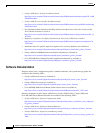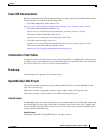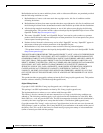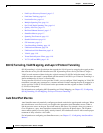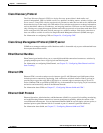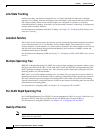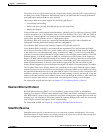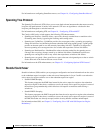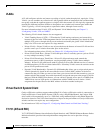
1-4
Software Configuration Guide—Release 15.0(2)SG
OL-23818-01
Chapter 1 Product Overview
Layer 2 Software Features
Flex Links and MAC Address-Table Move Update
Flex Links are a pair of Layer 2 interfaces (switch ports or port channels) where one interface is
configured to act as a backup to the other. The feature provides an alternative solution to the Spanning
Tree Protocol (STP). Flex Links are typically configured in service provider or enterprise networks
where customers do not want to run STP on the switch.
MAC Address-Table Move Update allows a switch to provide rapid bidirectional convergence when a
primary (forwarding) link goes down and the standby link begins forwarding traffic.
For information about Flex Links and MAC Address-Table Move Update, see Chapter 19, “Configuring
Flex Links and MAC Address-Table Move Update.”
Internet Group Management Protocol (IGMP) Snooping
IGMP snooping manages multicast traffic. The switch software examines IP multicast packets and
forwards packets based on their content. Multicast traffic is forwarded only to ports with attached
hosts that request multicast traffic.
Support for IGMPv3 provides constrained flooding of multicast traffic in the presence of IGMPv3
hosts or routers. IGMPv3 snooping listens to IGMPv3 query and membership report messages to
maintain host-to-multicast group associations. It enables a switch to propagate multicast data only
to ports that need it. IGMPv3 snooping is fully interoperable with IGMPv1 and IGMPv2.
Explicit Host Tracking (EHT) is an extension to IGMPv3 snooping. EHT enables immediate leave
operations on a per-port basis. EHT can be used to track per host membership information or to
gather statistics about all IGMPv3 group members.
The IGMP Snooping Querier is a Layer 2 feature required to support IGMP snooping in a VLAN
where PIM and IGMP are not configured because the multicast traffic does not require routing.
With SSO support, Stateful IGMP Snooping propagates the IGMP data learned by the active
supervisor engine to the redundant supervisor engine so that when a switchover occurs, the newly
active supervisor engine is aware of the multicast group membership, which alleviates a disruption
to multicast traffic during a switchover.
For information on configuring IGMP snooping, see Chapter 23, “Configuring IGMP Snooping and
Filtering.”
IPv6 Multicast Listen Discovery (MLD) and Multicast Listen Discovery snooping
MLD is a protocol used by IPv6 multicast devices to discover the presence of multicast listeners
(nodes that want to receive IPv6 multicast packets) on its directly attached links and to discover
which multicast packets are of interest to neighboring nodes. MLD snooping is supported in two
different versions: MLD v1 and MLD v2. Network switches use MLD snooping to limit the flood
of multicast traffic, causing IPv6 multicast data to be selectively forwarded to a list of ports that want
to receive the data, instead of being flooded to all ports in a VLAN. This lessens the load on devices
in the network, minimizing unnecessary bandwidth on links, enabling efficient distribution of IPv6
multicast data.
For information on configuring multicast services, see Chapter 24, “Configuring IPv6 MLD
Snooping.”



